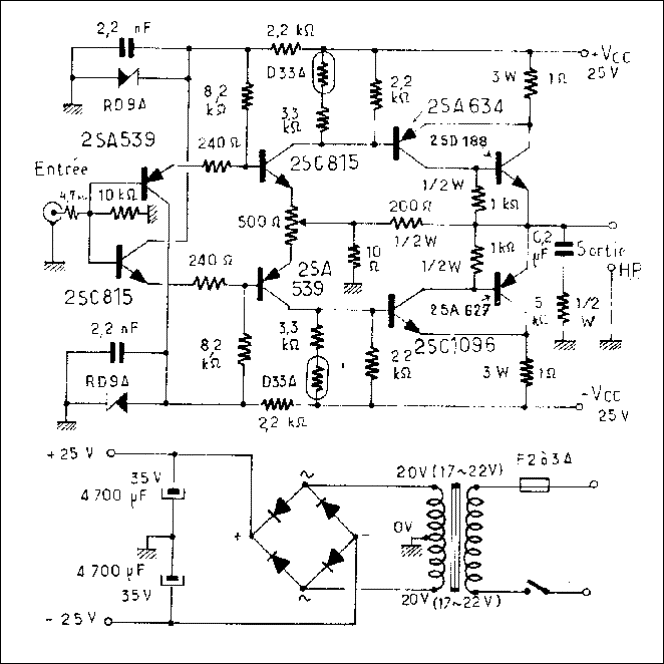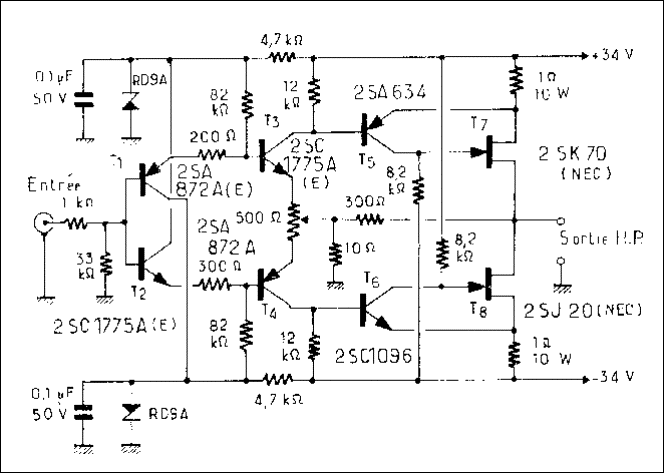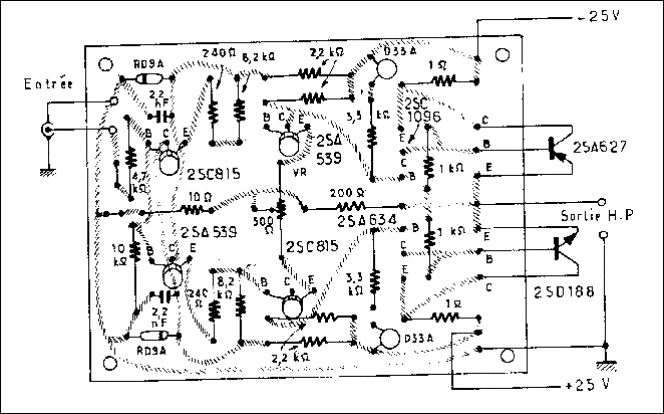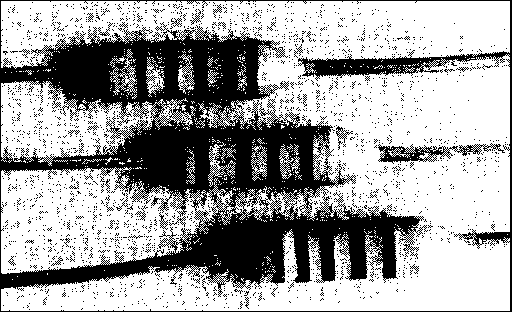The Class-A Amplifier Site
This page was last updated on 9 August 2001
Construction of a 20W class A amplifier
2. Construction
Jean Hiraga
(l’Audiophile No. 11)
The first part of the article on this amplifier is presented in the preceding issue. At the present time it is difficult to find diagrams of high quality class A amplifiers, moreover, the circuit described offers many benefits, in particular a great simplicity of construction. So that the reader may be reassured, we will describe in this article the various aspects of construction by attacking the passive components to use, the heatsinks, the power supply and the chassis.
A little history...
Before returning to the point of the subject, we would specify to you that the circuit described (fig. 8 Issue 10) is not actually a completely original circuit. It is an improvement of a circuit going back nearly two years, and marketed as a kit under licence in Japan. This amplifier met with a very great success for its cost price, its ease of assembly and its reduced dimensions. For French readers, we have introduced some improvement to the original diagram. This is characterized by a symmetrical power supply with a slightly higher voltage of +/-25 V and use of different complementary transistors. In fact, the value of the voltage is not very critical since it can vary, for this diagram, between 19 and 26V, without modification. As regards the transistors, the original diagram (fig. 1) employs a complementary pair 2SA539/2SC815 which are close to those used in our design, the SA872A/2SC177A. The latter, more recent devices, have however better performance in the parameters of noise, Cob and Ft. In addition, the higher supply voltage offers a slight increase in power, to between 20 and 21 W without distortion, whereas the improved circuit is limited to 18 W under these conditions, 20 W at the maximum in extreme cases of the clipping, because of the reduction in the power supply to + and - 18 V This reduction gives advantages with many other criteria, it is for this reason that we retained it.

Fig. 1: Unmodified version of the circuit.
Upgrading capability of the circuit
The improved diagram can be modified so that the class of operation moves from mode A to mode AB. The modification is simple and relates only to 12 kohm resistors, which are replaced by higher values. The power available is thus largely doubled, the supply voltage having however to be increased.
However, in the case of using speakers with a relatively good output (as realised by Y. Neveu and J Mahul) the amplifier as described is sufficient in many systems intended for reproduction in an apartment, the noise level it makes can be very high.
However, the diagram can evolve with regard to the power. The basic circuit is not called into question, the changes relate to the power supply, the heatsinks and the transistors. The technology of the vertical field effect semiconductors, power V FET, makes it possible to obtain nearly 60 W in pure class A. Figure 2 shows the modifications to be made; it will be noticed that the basic module, the printed circuit, remains unchanged.

Fig. 2: Modified version, class A, 60 Watts, using V-Fet transistors at the output .
Obtaining higher power passes naturally to the choice of other power transistors, such as V FET, R.E.T. (Ring Emitter Transistor), MOS FET, VMOS FET, and bipolar. It is necessary to note that the paralleling of output stages is not possible if the preceding stage does not have itself a parallel structure. Indeed, in the particular layout of the output stage, reversed Darlington, the driver transistor and the output transistor do not constitute, from a functional point of view, that of a single transistor. However, an output stage consisting of paralleled power transistors limits the performances as regards band-width and distortion, compared to a stage consisting only of a suitably selected single transistor with a higher Pc. In all the cases, the increase in the output power is accompanied by an increase in capacitance Cob which is already sufficiently significant to limit the performance.
This can appear to be in contradiction with many " commercial " circuits. It should well be seen that at the mass production level, economic considerations are necessarily taken into account. In the catalogues of the American manufacturers in particular, there are transistors of very high power, with a Pc of more than 350 W, available in complementary pairs. In spite of this, in the construction of high power amplifiers, one prefers to employ the parallel layouts of transistors at a much lower cost price. The manufacturers can say what they want, but the perfect complementary pairs do not exist yet, in power transistors particularly. The use of a parallel arrangement inevitably results in placing the power transistors on various points of the heatsink. Also, the slightest variations in temperature immediately disperse the pairs, and inevitably disturb the operation of the amplifier. This is why we wait before publishing the description of an amplifier with high power and high quality. The progress of solid state physics and of semiconductors in particular, is so fast that we are persuaded that within one year, one will be able to find in the power MOS FET and VMOS FET series, transistors such that it will be possible to design a 100 W class A amplifier using only four transistors in all. Because let us not forget that simplicity is a decisive criterion. At which time the prepreamp/preamp/amp unit uses only five or six stages in total?
Printed circuit
Figure 3 shows the printed circuit of the unmodified version. In figure 4, one finds the printed circuit of the improved version and the location of the components. The circuit is made out of epoxy glass whose conducting tracks have a 70 microns thickness. These are silver plated. The assembly after soldering is not covered with varnish.
The width of the printed tracks is often the object of discussion. It should well be seen that if the linear electrical resistance of the tracks were null, the best solution would be to use tracks of very low width, rather than of the broader traces bringing higher stray capacitances. The same observations are essential for the earth circuits.
As for the circuits of preamplifiers, whether they are with valves or transistors, the construction of an amplifier must observe the following conditions:
- Short connections
- Input far away from the output
- Distribution of the currents for the various sections of the circuit starting from a given point, the power supply for example. This distribution will be done preferably by separate tracks when this is possible, if not it will be necessary to recourse to tracks thickness from 70 to 120 microns or, to solder onto the circuit a copper wire of 1 mm^2 diameter
- Use of epoxy glass (the difference in price for circuits of small surface is far from important)
- Length of the equivalent tracks in the case of a symmetrical circuit.
These various aspects of detail can contribute largely to the subjective qualities. It should not be forgotten either that a printed circuit is not an improvement compared to an assembly in the air, it is simply an enormous practical advantage. However, degradations are increasingly more significant in the case of a printed circuit. Thus for some famous pieces of equipment, noticeable improvements were observed by the simple act of doubling up certain printed tracks with copper wire. Naturally, these considerations are only of a subjective nature, because the means of investigation and analysis we have at the present time are not sufficiently "refined" to explain such influences.

Fig. 3: Unmodified version, location of the components.

Fig. 4 Printed circuit, modified version, rear view, solder side, and equivalent view component side (printed circuit seen in transparency). Scale 1.
Following the same idea, the loudspeaker output connectors used (figure 5) offer excellent characteristics. They are made up, for the conducting part, from pure copper formed under vacuum, called "oxygen free", with direct plating. They were designed to be used with large section cables, up to 3,2 mm^2.

Fig. 5: Example of very high quality loudspeaker terminals (Japanese craftsman made), capable of receiving 3.2 mm^2 diameter cables.
Chassis
The design of the chassis for a class A amplifier inevitably passes to the installation of the heatsinks. We have indicated in the first part a possible solution. If this is satisfactory from the thermal point of view, it is not so much so from the aesthetic point of view. On the basis of a 19” rack, one can place two or four heatsinks, mono or stereo version, in line on the back face. Below these heatsinks could be located the inputs and the outputs, with the small disadvantage of accessibility. There is, of course, the solution of placing the heatsinks inside the rack. But this is relatively critical, taking into account the great inherent thermal dissipation with class A operation. If, despite everything, this solution is adopted, one will choose for the top and the bottom, a grid or a very well ventilated panel.
Let us benefit this article by examining the various layouts encountered in the amplifiers of this kind.
a. In the interior of the chassis: either the heatsinks are larger, or the use of a fan proves to be necessary, if not the temperature inside the chassis very quickly becomes very significant and causes heating of the components which often tolerate this very badly: electrolytic capacitors primarily, the mains transformer and the printed circuits comprising the driver and input stages.
b. On the back of the chassis: the ventilation is better but the surface is generally reduced to the dimensions of the box. In addition, this arrangement limits the accessibility to the inputs and the outputs.
c. On the front, this is a very original solution which provides good ventilation. Moreover, even when placed in a badly ventilated place, the front face is in general unrestricted.
d. On the sides, the power is limited to 30 W class A for a stereo apparatus. For higher powers, it is necessary to have recourse to other solutions.
e. On the sides and the back: the dissipation surface is much larger, it is a solution adopted by many American and Japanese manufacturers.
f. Laid out in a square with the fins placed inside thus constituting a chimney inside which must be placed a fan. This solution however is not the best.
Certain manufacturers, like Mitsubishi or Sony have resorted to solutions much more elegant such as fins cooled with freon or the "Heat pipe". The latter technique, developed by Sony, consists of a copper tube, filled with freon vapour, one end comprises cooling ribs; on the other end are fixed the power transistors which are thus located very close to each other, and are thus placed under excellent conditions from the thermal variation point of view.
Another solution consists of using copper heatsinks, or even aluminium with copper to improve the thermal conductivity, but this then poses problems of manufacture.
To remain practical, one must therefore gain surface. In a normal rectangular chassis, the sides and the back offer only a small part of the total surface. The top and the underside in fact are only very seldom used, however if one wants to release much heat, it is obvious that one must bring together the devices designed for this purpose, the heatsinks! It is indeed more astute to lay out the walls with larger surfaces vertically, so as to dissipate the maximum amount of heat. This is most probably the solution which will be adopted for the construction of the 50 W. The advantages are as follows: heatsinks with a large surface, significant chimney effect, reduced side area, possibility of thermally separating the input stage and the power supply from the power stage (figure 6). Naturally, this elegant solution can be adapted for the present construction. The only difficulty being obtaining a suitable aluminium section. Fortunately, there are many shapes and sizes of heatsinks available in the trade. If however, this poses problems, it is possible to make an assembly of heatsinks on two copper or aluminium plates, by using silicone grease or certain new synthetic products that are even more effective, among which one can even find special adhesives for heatsinks.

Fig. 6: Example of the configuration of the chassis and the heatsinks allowing a maximum thermal dissipation, while thermally isolating the other components.
Passive components
The passive component count being very reduced, there are few things to say on these. The resistors are a 1 %, 1/2 W tantalum type, of small series Japanese manufacture. From the point of view of subjective influences, it is these which give less significant colouration and defects. The lead-out wires are of tinned copper and are connected to the body of resistor by caps also made out of copper. Only the 0.47 ohm power resistors are of the cement type, this because of the question of room and obstruction. The solder used is Multicore Savbit or Multicore LMP (figure 7).
The electrolytic capacitors used on the prototypes are models with very low series resistance, of Japanese origin and 150 000 uF value. Two other 39 000 uF capacitors were put in parallel to give 189 000 uF for each polarity of the power supply. These values are not very available in France.
Conclusion
This amplifier with its simple circuit is easy to adjust. It can evolve into a more powerful amplifier without major modifications. It presents, moreover, a very interesting quality-price ratio. With the exception of the output transistors and their driver transistors, this diagram can be " remade " starting with other transistors of European references, without much risk of failure. To preserve the maximum of its subjective qualities and a maximum reliability, its power is voluntarily limited to 18 W without audible distortions. This power is largely sufficient for speakers of average or rather good output. One should not lose sight of the fact either that any piece of equipment is only a compromise, which in this case is able to be improved. It is possible to fine-tune it, in particular at the power supply level: supplying power to the input stages by a separate circuit from that supplying the power stages, separation of the left and right power supplies... or from the example of experimental preamplifiers, the low symmetrical voltage of +/- 18 V can be provided by 6V car batteries, that is to say 6 in total, this being reserved for the fanatics.

Fig, 7: Tantalum resistors, of Japanese origin, type 1/2 W, 1 % tolerance; thermal stability 50 PPM. It is these which gave from any point of view the best results; when compared with more than twenty other types of resistors, including the famous ultrastable Vishay (+/- 5 PPM).
HISTORY: Page created 09/08/2001